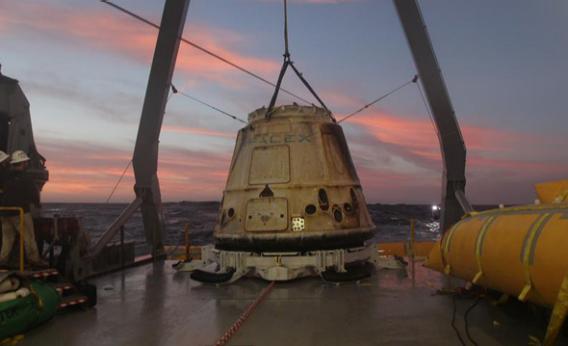Create a free profile to get unlimited access to exclusive videos, sweepstakes, and more!
A Day in Space: Two Missions Down, One to Go

Update, Feb. 11, 2015, at 23:45 UTC: Success! The Falcon 9 carrying the DSCOVR satellite lifted off on time, and was perfect; the payload is on its way to its destination 1.5 million kilometers from Earth. Congrats to SpaceX and everyone involved!
The past 24 hours have been busy for space flight, with mixed, but not bad results.
First, the SpaceX Dragon capsule successfully splashed down in the Pacific Ocean after a one-month stint on the International Space Station. It delivered needed cargo for the astronauts there, and brings back about two tons worth of trash as well as scientific experiment results. Congrats to SpaceX for that!
Unfortunately, the launch of the SpaceX Falcon 9 with the DSCOVR satellite on board was postponed again, this time due to upper level winds exceeding the allowable limit. When the rocket is moving supersonically, moving through these winds puts a tremendous load on it; on Twitter SpaceX CEO Elon Musk likened it to getting hit with a sledgehammer. The launch was delayed the first time due to the loss of an Air Force tracker, and a second time due to bad weather. Hopefully tonight, the fourth attempt, will be successful. That’s scheduled for 23:03 UTC (6:03 p.m. Eastern).
You can watch it live at the SpaceX Livestream, on their webcast channel, on NASA TV, or the NASA UStream channel.
Finally, the European Space Agency successfully launched and landed their testbed Intermediate Experimental Vehicle this morning, which is very cool! The IXV is testing out new designs, tech, and materials for possible future orbital flights. It launched from Kourou, French Guiana, and splashed down in the Pacific Ocean, just west of the Galapagos.
I had to laugh; I was boggling at how rapidly the Vega rocket leaps off the pad, and then the announcer says the same thing! This was a suborbital flight, so the rocket is much smaller and lighter than most launches we see these days. Orbital flights need a lot more speed and therefore more fuel … but that fuel has mass that you need to carry along upwards, so you need fuel to lift that. But that extra fuel needs more fuel to lift it, and so on. That means orbital flights need big rockets.
But this one didn’t, so the rocket was less massive, and was able to accelerate much harder at liftoff.
Congrats to the ESA for a successful mission!
And remember, we’re not done. The SpaceX flight is tonight, and later this week the ESA Automated Transfer Vehicle, Georges Lemaître, will leave the space station and come back to Earth, burning up on re-entry. Special cameras have been mounted inside the ATV to record the event as it happens, so that should provide very, very interesting footage. Stay tuned.


























